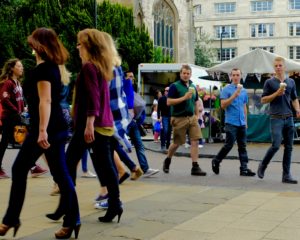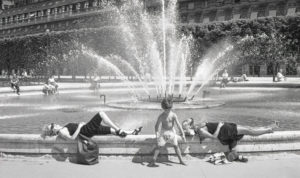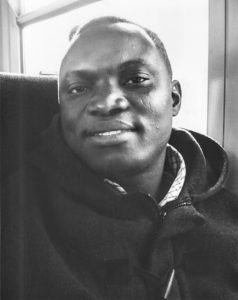 ‘Street photography: observing or connecting?’ was the question Jane Lynas and I posed to the U3AC Photography Forum yesterday. Our starting points were that street photography: pictures people and everyday life in public spaces; relies on serendipity and ambiguity; explores new insights and relationships; celebrates and challenges; creates pictures unique to the medium; and is where aesthetics rubs up against ethics. We presented a three part narrative: background and history; examples of my photography; and a portfolio of work by Jane.
‘Street photography: observing or connecting?’ was the question Jane Lynas and I posed to the U3AC Photography Forum yesterday. Our starting points were that street photography: pictures people and everyday life in public spaces; relies on serendipity and ambiguity; explores new insights and relationships; celebrates and challenges; creates pictures unique to the medium; and is where aesthetics rubs up against ethics. We presented a three part narrative: background and history; examples of my photography; and a portfolio of work by Jane.
 The background looked at the development of street photography, from the earliest example by Louis Daguerre (1838) through to modern work by Harry Gruyaert (2012). On the way it embraced: early forays onto the street (Charles Negre c.1855); views from abroad (John Thompson, c. 1973-84); the democratisation of photography (Jacques-Henri Lartigue, 1911); the organised picture (Andre Kertesz, 1928); news content (Bert Hardy, 1951); the sad ballad of American life (Robert Frank, 1958-9); street photography culture (Joel Meyerowitz, 1975); and remote photography (Philip-Lorca Dicorcia 2001). We ended with a picture of the Market Square, Cambridge, by David Runnacles.
The background looked at the development of street photography, from the earliest example by Louis Daguerre (1838) through to modern work by Harry Gruyaert (2012). On the way it embraced: early forays onto the street (Charles Negre c.1855); views from abroad (John Thompson, c. 1973-84); the democratisation of photography (Jacques-Henri Lartigue, 1911); the organised picture (Andre Kertesz, 1928); news content (Bert Hardy, 1951); the sad ballad of American life (Robert Frank, 1958-9); street photography culture (Joel Meyerowitz, 1975); and remote photography (Philip-Lorca Dicorcia 2001). We ended with a picture of the Market Square, Cambridge, by David Runnacles.
 My part included photographs from four projects, travels, ruckenfigur revisited, travellers and mannequins, which considered street photography as observation. The pictures illustrated my approach, which is to focus on individuals and small groups picked out from the crowd, showing relationships between them or with their surroundings. The pictures are not complex, though I aim to reveal subtle relationships and provoke thought. They are often reflective and capture quiet moments. Sometimes a quirky vein of humour emerges. My challenge as the photographer is to become invisible, to wait and work around opportunities without being seen to loiter. A long lens is a no-no; getting in close is the answer.
My part included photographs from four projects, travels, ruckenfigur revisited, travellers and mannequins, which considered street photography as observation. The pictures illustrated my approach, which is to focus on individuals and small groups picked out from the crowd, showing relationships between them or with their surroundings. The pictures are not complex, though I aim to reveal subtle relationships and provoke thought. They are often reflective and capture quiet moments. Sometimes a quirky vein of humour emerges. My challenge as the photographer is to become invisible, to wait and work around opportunities without being seen to loiter. A long lens is a no-no; getting in close is the answer.
 Jane spoke about street photography as connection, introducing this through the work of Diane Arbus, William Klein, Martin Parr and William Eggleston. She explained how her work, which started as a project to photograph the hands of people in the street, evolved into paired photographs of hands and portraits. This could only be achieved by: assessing whether potential subjects would be likely to respond well to a request to take pictures; and connecting with them, often in lengthy conversations. The hands reveal a lot about the people she met and the portraits take this further, sometimes in surprising directions. Jane’s stories of the people she met were an essential complement to the pictures.
Jane spoke about street photography as connection, introducing this through the work of Diane Arbus, William Klein, Martin Parr and William Eggleston. She explained how her work, which started as a project to photograph the hands of people in the street, evolved into paired photographs of hands and portraits. This could only be achieved by: assessing whether potential subjects would be likely to respond well to a request to take pictures; and connecting with them, often in lengthy conversations. The hands reveal a lot about the people she met and the portraits take this further, sometimes in surprising directions. Jane’s stories of the people she met were an essential complement to the pictures.
 Oour presentation and the discussion in the Forum showed that street photography can embrace both observation and connection and our title suggested a false dichotomy. The two approaches require different mind and skill sets and they exist along a continuum of street photography, not as discrete activities. With integrity, good luck and some technical ability both can achieve something that goes beyond the record.
Oour presentation and the discussion in the Forum showed that street photography can embrace both observation and connection and our title suggested a false dichotomy. The two approaches require different mind and skill sets and they exist along a continuum of street photography, not as discrete activities. With integrity, good luck and some technical ability both can achieve something that goes beyond the record.
All of the pictures in the presentation will be published at www.zimbushboy.org.
Photos: 1. Market Square, Cambridge, David Runnacles, c. 2010; 2.Jardin du Palais Royal, Paris, Brian Human, 1990; 3. TGV Lille-London, France, Brian Human, 2011; 3 & 4 Pictures from hand and portrait study, Jane Lynas.
